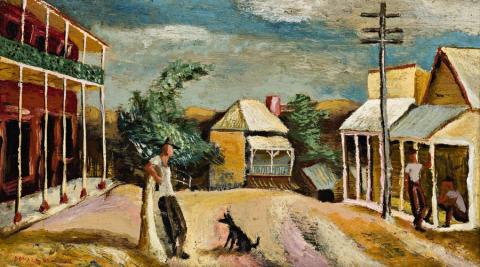HILL END, THE ROYAL HOTEL AND GENERAL STORE, 1949
DONALD FRIEND
oil on card
14.5 x 26.0 cm
signed and dated lower left: DONALD 49
The discovery of Hill End in 1947 by Donald Friend and Russell Drysdale was a serendipitous moment in Australian art, inspiring them to new heights, and resulting in iconic works such as Drysdale's masterpiece, The Cricketers, 1948. It all began on a day in August when Drysdale had just bought a new car and Friend, by chance, was reading a newspaper story about the old gold rush towns in the Bathurst region of New South Wales. A trip to Sofala and Hill End satisfied curiosity and helped run in the car. They were fascinated by what they saw, Robert Hughes in his 1965 book on Friend describing Hill End as 'once a boom town with 50,000 wenching, digging, boozing and fortune-hunting inhabitants, now a collection of ruined, overgrown or run-down buildings, with a pub and general store, occupied by a handful of people who lived by fossicking or rabbiting'.1 Within a few weeks of their visit, Friend bought a wattle and daub cottage, the Royal Hotel near by. He enjoyed the local characters as much as the landscape, writing in his diary shortly after his arrival: When we returned in the evening Hill End's Saturday drink-fest was in full swing - the bar a Hogarthian scene of peasant drinking and merriment 'The bar was very full and so were most of the drinkers.'2
Populating his oeuvre with drawings, watercolours and oils of Hill End, the pub and the store featured both for their picturesque appeal and as places of general meeting " as witnessed by the locals in our painting. The presence of the black dog seated in the main street adds a further touch of the informal, the whole painting redolent with indolence and the laconic lean. In the warmth of a sunny day there are no clouds of significance, real or metaphoric, to trouble the scene, even if the roads appears to fall off the end of the earth once past the rise. The abrupt fall does, however, have a hint of Surrealism, so apparent in Drysdale's The Cricketers and other Hill End works. There was a strong affinity between Friend's and Drysdale's work at this time seen also in the lean and lanky. In later works, such as (Hill End Landscape), c1951 in the collection of the Tasmanian Museum and Art Gallery, Hobart, the unique locale brought out even more the latent Surrealism in Friend's work. By 1949, Friend had been living there long enough to imbue Hill End, The Royal Hotel and General Store with all the local character, found as much in the architecture as in the hatted individuals themselves.
1. Hughes, R., Donald Friend, Edwards and Shaw, Sydney, 1965, p. 56
2. Friend, D., The Diaries of Donald Friend, vol. 2, edited by Paul Hetherington, National Library of Australia, Canberra, 2003, p. 544, entry for 14 September 1947
DAVID THOMAS
